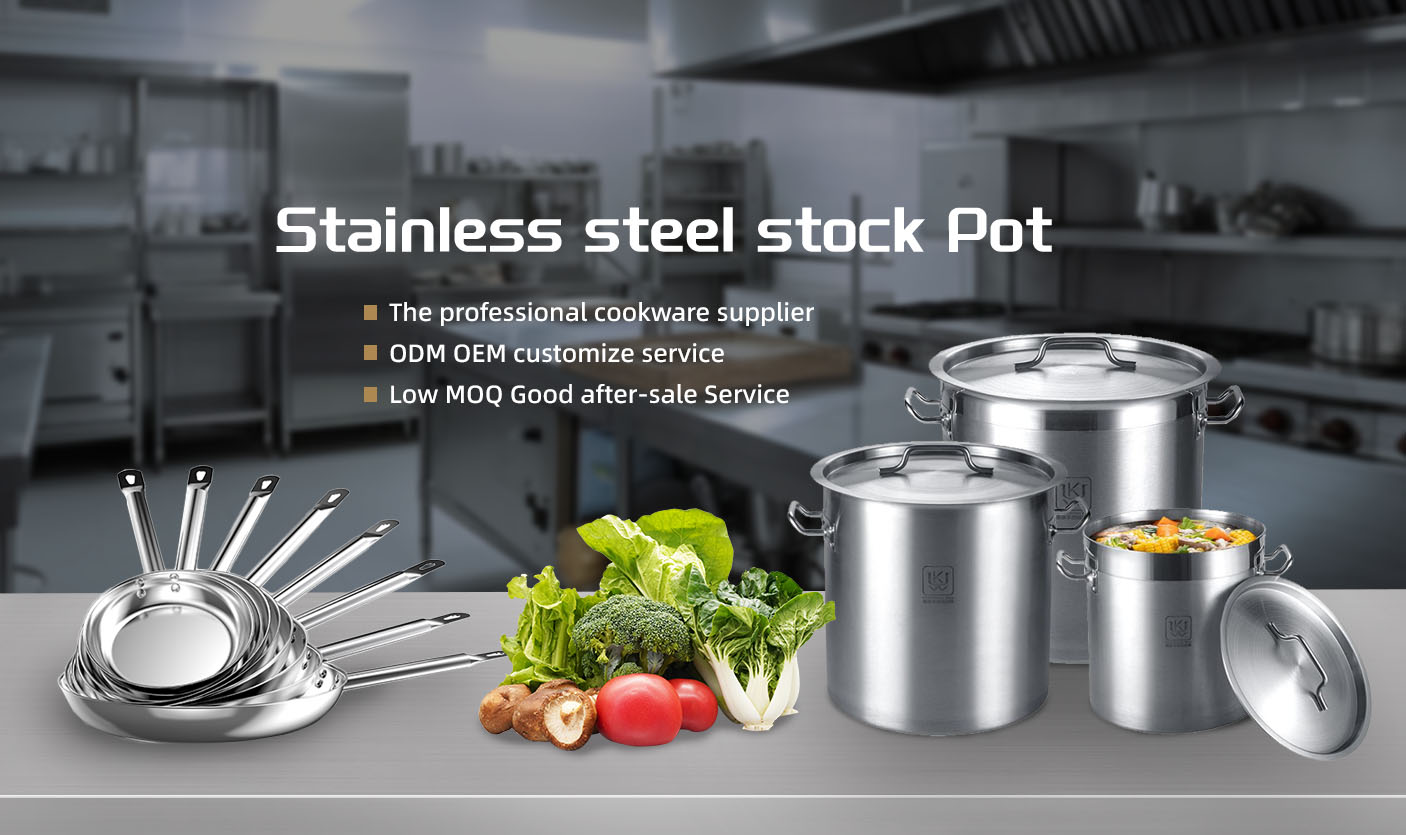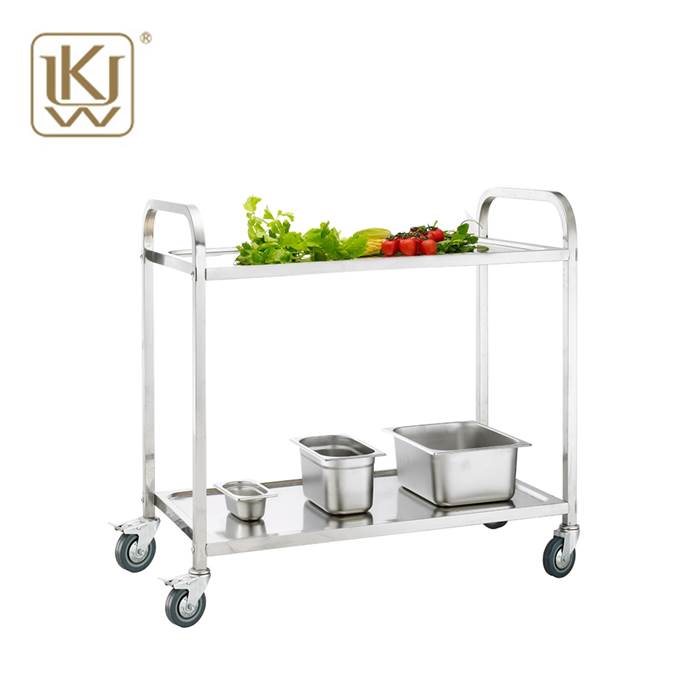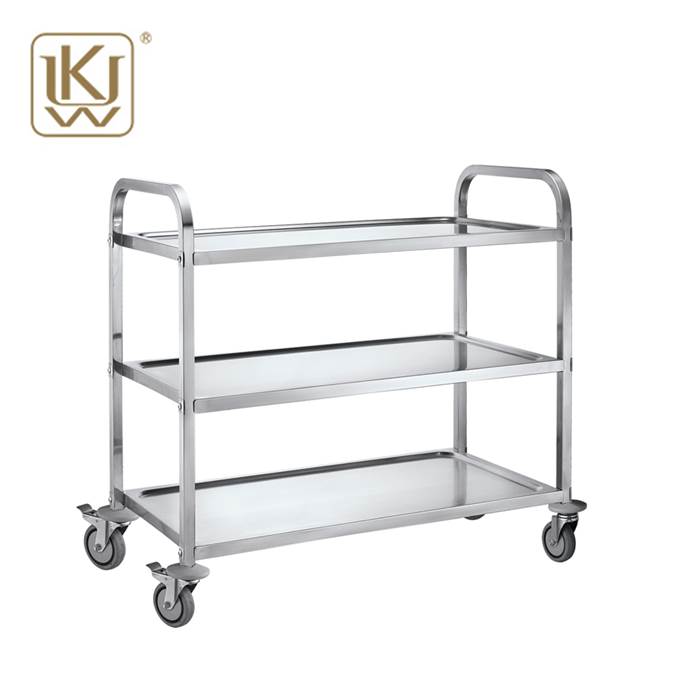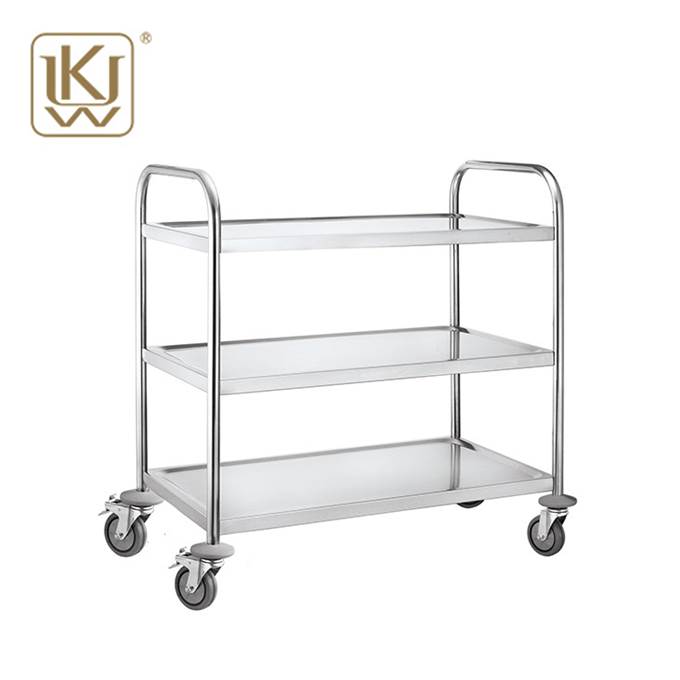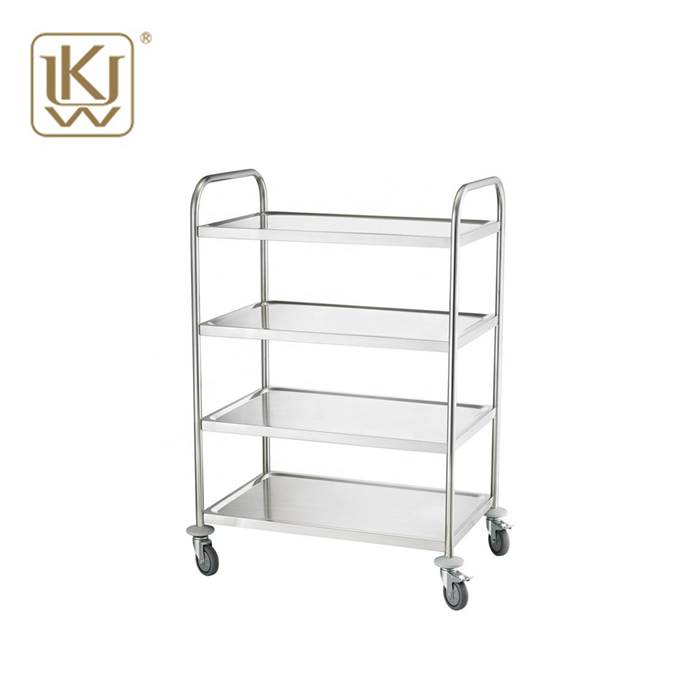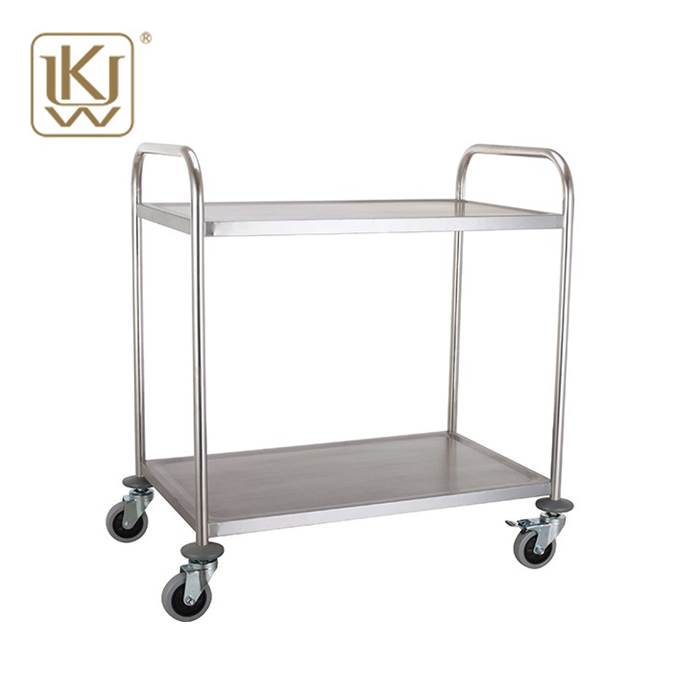2 Tiers Stainless Steel Kitchen Utility Cart
- Product Information
Stainless Steel Kitchen Utility Cart is a tool designed for food transportation and related service scenarios. This trolley is made of stainless steel as a whole, mainly composed of two layers of flat stainless steel plates as the load-bearing platform, and the plate surface usually has no high edges around it to facilitate the placement of items.
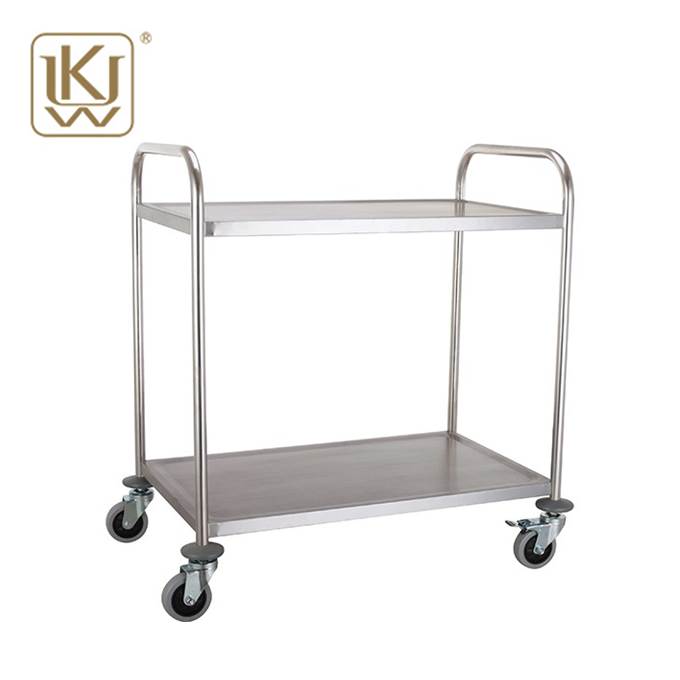
Stainless Steel Kitchen Utility Cart Parameters:
| CODE | Dimension(mm) |
| FR-L2 | 950*500*950 |
| FR-M2 | 850*450*900 |
| FR-S2 | 750*400*835 |
Stainless Steel Kitchen Utility Cart Features:
Excellent material: Stainless steel is one of the core features of this Stainless Steel Kitchen Utility Cart. Stainless steel is extremely durable, and its surface is finely processed to present a smooth texture. This material can resist scratches and collisions in daily use, and is not easy to get dents or breakage. Moreover, stainless steel will not rust as easily as some other metal materials, and it can maintain its original structure and appearance even if used for a long time in a humid environment.
Strong carrying capacity: From a structural point of view, the upper and lower layers of stainless steel plates of the trolley are of moderate thickness, which can evenly distribute the weight of the items carried. Its frame structure has also been carefully designed, and the various components are firmly welded, so that the entire trolley has a strong carrying capacity. Generally speaking, it can easily carry dozens of kilograms of items, which is very suitable for transporting a large amount of tableware, food raw materials or finished foods, etc., and meets the daily transportation needs of places such as restaurant kitchens and canteens.
Easy to push and pull: The stainless steel handles on both sides are reasonably designed, with a moderate height and ergonomic principles. When pushing or pulling the trolley, the operator can naturally hold the handle and apply appropriate force to easily push the trolley to move. The surface of the handle is smooth and will not cause cuts or other injuries to the palm. Due to the characteristics of stainless steel, the handle will not wear out after long-term use and affect the grip. In addition, the trolley has flexible steering and can be easily manipulated in straight channels or areas that need to turn, which is very practical in environments such as kitchen channels or restaurant aisles with limited space.
Easy to clean: The surface of stainless steel is smooth and seamless, which makes it difficult for dirt, oil stains, etc. to adhere. When cleaning, just use a damp cloth dipped in an appropriate amount of detergent to gently wipe the surface to quickly remove stains and restore the trolley to a clean state. And because its material is not as easy to hide dirt as some porous materials, the cleaned trolley can meet higher hygiene standards and meet the strict requirements of the food service industry for environmental hygiene.
Good antibacterial performance: Stainless steel itself has certain antibacterial properties. In food service scenarios, it is very important to reduce bacterial growth. The stainless steel surface of this trolley is not easy to breed bacteria. Even after transporting some foods that are easy to carry bacteria, after a simple cleaning process, it can effectively reduce the risk of bacterial residue and ensure the safety and hygiene of food during transportation.
Simple and beautiful appearance: Its overall design is simple and generous, and the silver stainless steel appearance looks clean and tidy in various service places. This simple appearance style can be well integrated into various restaurants, hotels, canteens and other environments without appearing abrupt. And because of its smooth and shiny surface, it can also play a certain decorative role under appropriate light, enhancing the overall visual effect of the service area.
Stainless Steel Kitchen Utility Cart Application:
Catering Industry: In restaurants, Stainless Steel Kitchen Utility Cart is an important means of transportation between the kitchen and the front hall. The kitchen staff can place the prepared dishes on the upper layer of the trolley, and the lower layer can be used to place tableware, plates and other supporting supplies. The trolley can quickly and stably transport the food from the kitchen to the various tables in the restaurant, making it convenient for the waiter to serve the dishes. At the same time, after the restaurant closes, the trolley can also be used to collect used tableware and transport it from the restaurant back to the kitchen for cleaning and disinfection, thereby improving the efficiency of restaurant operations and ensuring the smooth service process.
Hotel catering services: The hotel's catering department is also inseparable from this trolley. In the hotel's buffet restaurant, it is used to transport various breakfast, lunch and dinner foods from the kitchen to the buffet table to ensure that the food can be supplied to the guests in a timely and fresh manner. In the hotel room delivery service, the trolley can be loaded with meals, drinks and other items, so that the waiter can deliver them to the door of the guest's room, providing guests with a convenient delivery experience. In addition, in various banquets, conferences and dining scenes held in hotels, trolleys are also key tools for transporting food, tableware and other materials to ensure the quality and efficiency of hotel catering services
School canteen: School canteens need to provide catering services for a large number of students every day. Stainless steel food service trolleys are widely used in canteens. Kitchen staff can use it to transport cooked meals from the cooking area to the dining area, with hot dishes on the upper layer and lunch boxes, soup bowls and other tableware on the lower layer, which is convenient for canteen aunties to perform meal distribution operations. At the same time, it can also be used to transport ingredients from the food storage warehouse to the kitchen processing area to ensure the timeliness of food supply, maintain the efficiency of daily operations in the canteen, and provide students with timely and delicious meals.
Hospital canteen: In the hospital environment, food hygiene and transportation efficiency are crucial. stainless steel food service trolleys are used in hospital canteens to transport patients' meals to various wards. Due to the antibacterial and easy-to-clean characteristics of its material, it can ensure the hygiene and safety of patients' food during transportation. Medical staff can place the prepared nutritious meals on the trolley and conveniently deliver them to the patient's bedside, which is helpful for the patient's recovery and nutritional intake. In addition, some medical areas within the hospital, such as the rest area around the operating room, also need this trolley to transport the working meals of medical staff to ensure the normal development of the hospital's overall catering services.
Food processing factory: In the food processing workshop, this trolley is used to transport raw materials and semi-finished products. For example, in a baking factory, it can load raw materials such as flour, sugar, and butter from the warehouse to the workbench in the processing workshop; in a meat processing plant, it is used to transport cut meat raw materials to different processing positions. Its stainless steel material can meet the strict requirements of the food processing industry for hygiene and cleanliness, prevent the raw materials from being contaminated during transportation, and its sturdy structure and good carrying capacity can also adapt to the frequent transportation needs within the factory and improve production efficiency.
Takeaway delivery point: For some centralized points for takeaway delivery, such as the delivery station of the takeaway platform or the takeaway preparation area of the catering company, the stainless steel food service trolley is used to sort and load takeaway orders. The upper layer can be used to place packaged meals, and the lower layer can be used to place takeout boxes and other packaging supplies, so that the delivery personnel can quickly pick up and deliver the meals. It can ensure that the meals are transferred from the meal preparation area to the delivery vehicle in an orderly manner in a short time, improving the efficiency of takeout delivery. And because it is easy to clean, it is also convenient to keep it clean when frequently changing the takeout order loading to avoid cross contamination.
Stainless Steel Kitchen Utility Cart Maintenance:
Regular cleaning: Stainless steel food service trolleys need to be cleaned regularly and thoroughly. After daily use, wipe the surface with a damp cloth to remove dust, food residues and other dirt on the surface. For stubborn stains, you can use a special stainless steel cleaner. After diluting according to the product instructions, use a soft cloth to dip the detergent solution and gently wipe the stain, then wipe it clean with clean water, and finally wipe it with a dry cloth to prevent water stains from remaining and causing watermarks or rust on the surface. The wheels, handles and other details of the trolley should also be deeply cleaned every week. Use a small brush to brush away dust and dirt in the gaps to ensure that the entire trolley remains clean and hygienic and prolong its service life.
Pay attention to moisture-proof: Although stainless steel has a certain degree of corrosion resistance, it may still be adversely affected by being in a humid environment for a long time. When storing the trolley, try to choose a dry and ventilated place, avoid places near water sources or places with water vapor. If the trolley is accidentally soaked in water, it should be wiped dry with a dry cloth immediately, especially the bearing parts of the wheels and the joints of the handles, which are prone to water accumulation, to prevent moisture from penetrating and causing rust. During periods of high humidity, such as the rainy season, you may consider placing some desiccant in the area where the trolley is stored to reduce the humidity of the surrounding environment and protect the trolley from moisture.
Reasonable loading: In order to ensure the normal use of the trolley and extend its service life, you should follow the reasonable load principle when loading items. Do not exceed the maximum load weight of the trolley, otherwise it may cause problems such as deformation of the trolley frame and damage to the wheels. At the same time, when placing items, try to distribute the weight evenly to avoid one side being too heavy and the other side being too light. This can prevent the trolley from tilting and shaking during movement and reduce unnecessary wear on parts such as handles and wheels. For example, when loading tableware and food, heavier items can be placed on the lower layer and close to the center of the trolley, and lighter items can be placed on the upper layer to maintain overall balance.
Check the condition of the wheels: The wheels are one of the key components of the stainless steel food service trolley and their condition needs to be checked regularly. Check whether the wheels can rotate flexibly and whether there is a jamming phenomenon every week. You can gently rotate the wheel. If you find that the rotation is not smooth, it may be that the bearing part is short of oil or foreign objects have entered. At this time, you should first clean the foreign objects around the bearing, and then add an appropriate amount of lubricating oil to ensure the normal rotation of the wheel. At the same time, check whether the wheel brake is effective. After pressing the brake pedal, the trolley should be able to be stably fixed in place without sliding. If the brake device fails, the corresponding parts should be repaired or replaced in time to ensure that the trolley can be safely and reliably fixed when it needs to be fixed.
Protect the surface finish: The surface finish of the stainless steel trolley not only affects its appearance, but also its durability. In daily use, avoid wiping the surface with rough cleaning tools or strong acid and alkali cleaners to avoid scratching or corroding the surface. If there are slight scratches on the surface, you can use a special stainless steel polish and follow the product instructions to polish the scratched area to restore the surface finish. In addition, when carrying some items with sharp edges, be careful to avoid collision or friction between the items and the surface of the trolley, prevent new scratches or dents, and maintain the integrity and beauty of the trolley surface.
Regular disinfection: Since stainless steel food service trolleys are mainly used in food-related service scenarios, regular disinfection is an essential maintenance measure. In addition to daily cleaning, the trolley should be fully disinfected with food-grade disinfectants every week. According to the instructions for use of the disinfectant, dilute it and spray or wipe it on all surfaces of the trolley, including the load plate, handles, wheels, etc., then let it work for a while before wiping it clean with clean water, and finally dry it thoroughly. This can effectively kill bacteria, viruses and other microorganisms that may exist on the trolley, ensure the hygiene and safety of food transportation, meet the strict hygiene standards of the food industry, and provide users with healthy and reliable service guarantees.


